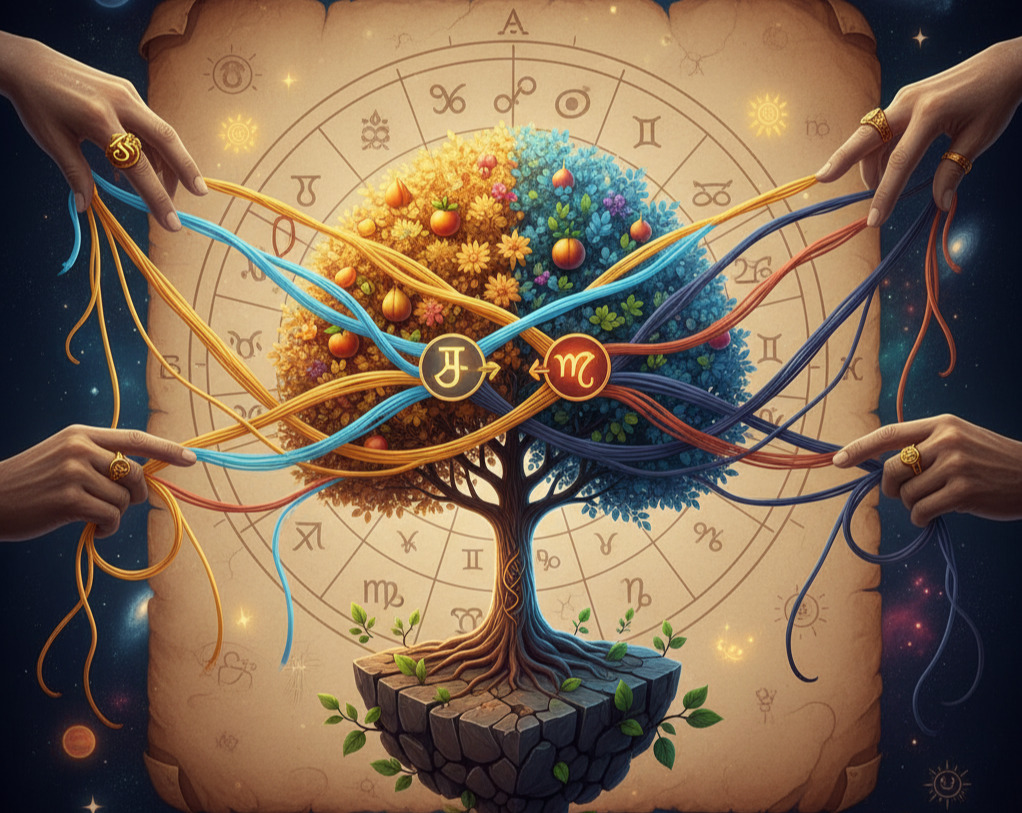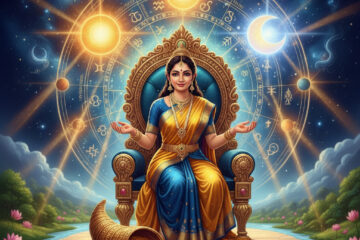To read a chart well, you have to understand yogas in Vedic astrology — not just the famous “good yogas,” but also the combinations that bring friction, delay, pressure, or emotional heaviness. This is Part II of our yoga series. We’re going to walk through both supportive and difficult yogas, explain what they actually mean in practice, and show you how to interpret them without superstition. You’ll notice a theme: most so-called “curses” turn into fuel for growth once maturity, timing, and dignity line up.
As always, one rule stands above the rest: no yoga is absolute. A yoga in a chart is potential. It takes dignity, house strength, bhaav-madhya proximity, dashas, and transits to decide how loudly that yoga will speak. And yogas rarely cancel each other in a clean way — they blend. A chart can hold a brilliant raj yoga and a difficult Shraapit Yoga at the same time. That’s real life: gifted and tested at once.
How to Read Yogas in Vedic Astrology (Before You Judge Anyone’s Destiny)
Before we get into specific yogas, you should always run these core diagnostics:
- Dignity and strength: Is the planet exalted, in own sign, vargottama, high Shadbala, supported by benefics — or is it combust, debilitated, starving for support? Weak dignity can distort even a “good” yoga. Strong dignity can redeem a difficult yoga.
- Functional nature: A natural benefic like Venus can act as a functional malefic for some ascendants if it rules tough houses. A natural malefic like Saturn can become a yoga karaka planet and act like a protective force. Never skip functional nature.
- House context: Dusthanas (6, 8, 12) often indicate struggle, but they can flip into transformation and eventual power (Vipreet Raj Yoga). Upachayas (3, 6, 10, 11) like pressure and get stronger with age, so a tough yoga there may become productive.
- Timing: Dashas propose, transits dispose. A yoga activates most strongly in the Mahadasha / Antardasha of its planets and when slow transits reinforce the same house axis. If it’s not “on the timeline,” it often stays mostly psychological.
Now, let’s go deeper into specific yogas — some auspicious, some challenging, all important for serious chart work. We’ll keep the numbering from Part I so you can build a study library.
X) Kahala Parivartana Yoga – Work Meets Fortune
Kahala Parivartana Yoga forms when the 3rd lord (effort, initiative, courage, self-made power) exchanges signs with a non-dusthana lord. The 3rd is an upachaya house: it improves with struggle and repetition. So this yoga tends to show uneven progress — bursts of ambition, reversals, recovery, then rise again. Think “scrapper energy.”
For example, if the 10th lord (career, public work) and the 3rd lord exchange, career will not be linear. Early career years may be volatile, political, or tiring. But across the dasha of either planet — especially after Saturn maturity — you often see a resilient public presence, someone who earns status through grit, not handouts.
Key nuance: Kahala Parivartana doesn’t promise comfort. It promises eventual capability. In modern terms it creates people who “don’t quit,” and who build credibility in competitive or high-pressure arenas.
XI) Dainya Parivartana Yoga – Exchange with a Dusthana Lord
Dainya Parivartana Yoga occurs when a dusthana lord (6th, 8th, or 12th) exchanges signs with a non-dusthana lord. Now we’re mixing clean houses with high-maintenance houses. This usually brings stress, obligation, and karmic friction to the topics ruled by both houses.
Example: an exchange between the 5th lord (creativity, intelligence, children, merit) and the 6th lord (conflict, debt, illness, service). This can show creative frustration, repeated tests with children or students, or “I must work twice as hard to prove myself.” When dignity is poor, this yoga can feel draining. When dignity is strong and the planets are friendly, the same stress becomes character-building: the person learns to weaponize adversity into skill.
So Dainya Parivartana is not “doom.” It’s karmic friction. You don’t ignore it — you manage it with discipline, health routines, boundaries, and maturity.
XII) Kartari Yogas – Scissors Around a House
Kartari means “scissors.” The idea is that a house is hemmed in, trapped between two planets in the adjacent signs. You judge whether that trap helps or hurts by looking at the natural nature of those planets (benefic vs malefic). Functional nature matters less here than the classic benefic/malefic category.
- Paap Kartari Yoga (malefic hemming): When a house is surrounded on both sides by natural malefics like Saturn, Mars, Rahu, Ketu, or a dark Moon, that house’s topics get pressured. Example: If the 7th house (marriage, partnership) is boxed in by Saturn on one side and Rahu on the other, relationship life may carry stress, delay, karmic intensity, or power struggles.
- Shubha Kartari Yoga (benefic hemming): When a house is surrounded on both sides by benefics like Jupiter, Venus, Mercury, or a bright Moon, that house gets protection and nourishment. The house behaves like it’s guarded by gentle advisors.
Note: For a real Kartari Yoga, both adjacent houses must be occupied. If only one side is occupied, it’s partial. Kartari around kendras (1, 4, 7, 10) is more dramatic because those houses anchor physical vitality, home, marriage, and career.
XIII) Daridra Yoga – Lessons Around Money
Daridra literally means poverty, but in modern interpretation it’s more about money instability, not lifelong misery. A common version occurs when the ascendant is dominated only by natural malefics (no benefic aspect, no benefic support), especially when those malefics do not rule auspicious houses like the 9th or 10th. The person may feel like money leaks out faster than it comes in, especially early in life.
Now here’s where nuance matters. If one of those “malefics” is actually a yoga karaka planet for that lagna — for example, Saturn for Libra rising — the so-called Daridra Yoga may flip: you get money through grind, responsibility, and structural effort. That is not romantic, but it is stable. So Daridra Yoga can mutate into a kind of work-forged prosperity, especially after Saturn maturity and once the native learns discipline.
In plain language: Daridra Yoga can show “no shortcuts.” But “no shortcuts” often becomes “incredible financial resilience by age 40+.”
XIV) Kemadruma Yoga – The Lonely Moon
Kemadruma Yoga forms when the Moon stands totally alone: no planets in the same sign, none in the previous or next sign (Rahu/Ketu don’t count), and no planet in any kendra from the ascendant. Classic texts say this brings poverty or misery. That’s overstated and fear-based. In lived charts, Kemadruma tends to show emotional isolation, self-doubt, or a sense of “I have to handle everything alone.”
But here’s the important teaching: the Moon matures through connection. Many natives with Kemadruma Yoga find relief through chosen family, mentorship, therapy, devotional practice, creative work, or spiritual discipline. When they stabilize emotionally — often in their 30s — this yoga becomes a well of empathy. These people can become powerful healers, counselors, or vision-holders because they understand</em loneliness. In other words, Kemadruma can mature into compassion.
XV) Shraapit Yoga – Saturn and Rahu
Shraapit (“cursed”) Yoga is the conjunction of Saturn and Rahu, especially within tight degrees or sharing a nakshatra. In internet astrology this gets sensationalized. Let’s sober it up. Saturn = karmic duty, Rahu = karmic hunger. When they fuse, the native often feels blocked, delayed, or burdened in the specific house they occupy. There can be invisible guilt or “I must pay a debt I don’t fully understand.”
This yoga is not automatically destructive. For Venus- or Saturn-ruled ascendants (Taurus, Libra, Capricorn, Aquarius), Shraapit Yoga sometimes shows as intense worldly ambition or institutional power, especially in the 3rd or 11th houses (effort, networks, influence). It can produce people who grind obsessively until they break through. In upachaya houses (3, 6, 10, 11), Shraapit Yoga can become a badge of ruthless competence.
Where it’s heavier: when Saturn and Rahu sit in the 8th, 12th, 1st, or 2nd. Then the burden can hit areas like health, self-esteem, stability, or family resources. The dignity of Saturn, the strength of the dispositor, and benefic aspects (especially Jupiter) are key to softening this.
XVI) Gajakesari Yoga – Moon and Jupiter in Kendras
Gajakesari Yoga is one of the most quoted “good yogas in Vedic astrology.” It forms when the Moon and Jupiter are in mutual kendras (1st, 4th, 7th, or 10th from each other). This links emotional intelligence (Moon) with wisdom and ethics (Jupiter). Results: social respect, mentorship support, intuitive judgment, and grace in crisis.
But it’s not automatic. If Moon is weak (say, very dark, in an enemy sign, or in Kemadruma-like isolation) or Jupiter is badly afflicted, Gajakesari Yoga can turn into emotional inflation: naïve optimism, rescuing others at your expense, or mood swings wrapped in moral language. The yoga does exist, but strength and dignity determine whether it becomes grounded wisdom or just sentimental bravado.
XVII) Guru-Mangal Yoga – Jupiter and Mars
Guru-Mangal Yoga forms when Jupiter and Mars conjoin or oppose one another. Mars brings force, courage, and action. Jupiter brings principle, conscience, and purpose. Together, they’re “righteous fire.” You see this in advocates, reformers, defenders, entrepreneurs who act with a mission.
When well dignified, this yoga supports ethical leadership: “I will fight, but for something meaningful.” When afflicted or placed in volatile houses, it can slide into moral aggression — crusader energy with poor impulse control. So the sign, house, and depositor of both planets matter a lot in Guru-Mangal Yoga.
XVIII) Visha Yoga – Moon with Saturn
Visha means poison. Visha Yoga is typically defined as Moon tightly conjoined Saturn. Emotion (Moon) blends with pressure, delay, responsibility, and karmic heaviness (Saturn). The result is often emotional seriousness, a tendency toward melancholy, or feeling “older than your age.”
But: if both Moon and Saturn are strong by dignity (for example, Moon in Taurus, Saturn in Capricorn or Aquarius), and if they aren’t under harsh malefic attack, this same yoga can produce enormous public influence. Why? Moon = popularity, Saturn = the masses. These natives often carry weight with communities because they speak from lived struggle. They’re taken seriously. So Visha Yoga is not always depression. Sometimes it’s authority built on pain.
XIX) Angarak Yoga – Mars with Rahu
Angarak Yoga is created when Mars and Rahu unite. Mars is raw drive and confrontation. Rahu is hunger, obsession, boundary-breaking. Together they create “unlimited acceleration.” When uncontrolled, Angarak Yoga can mean temper issues, impulsive decisions, or risky confrontations. It can show explosive anger if the planets are in inimical signs or sitting in sensitive houses like the 1st, 4th, 7th, or 8th.
In the right places, though — especially upachaya houses like the 3rd or 11th — Angarak Yoga can turn into unstoppable competitive spirit. Sports, entrepreneurship, activism, crisis operations, crisis management: “I run toward the fire when others run away.” Again we see the core pattern of many challenging yogas in Vedic astrology: same energy can save or scorch depending on maturity, house placement, and dasha timing.
XX) Chandra-Mangal Yoga – Moon and Mars
Chandra-Mangal Yoga forms when Moon and Mars conjoin or oppose. It famously connects mind (Moon) and initiative (Mars), and it often shows financial instinct. Many people with strong Chandra-Mangal develop business drive or “money sense,” especially when this yoga links to the 2nd or 11th houses of stored wealth and gains. The native can act quickly on gut impressions and turn ideas into action.
Shadow side: Moon + Mars can also be emotionally reactive. Clashes with the mother, domestic volatility, or a tendency to “decide first, cool down later” can appear if these planets are in enemy signs or under malefic pressure. When supported by benefic aspects — especially Jupiter — this yoga leans far more toward confident initiative than raw temper.
Important Notes
Do Rahu and Ketu ever independently form Raj Yogas?
By themselves, no. Rahu and Ketu are shadow points, not full grahas with house rulership in the classical Parashari sense. They amplify what they touch. If Rahu sits with a raj-yoga planet and that planet is strong, Rahu can turbocharge that raj yoga during Rahu dasha. But Rahu/Ketu aren’t “kings” alone — they’re magnifiers. So, they don’t independently form yogas in Vedic astrology.
Are yogas in Vedic astrology like Vipreet Raj Yoga and Neecha Bhang Raj Yoga really classical?
The core logic of yogas in Vedic astrology is classical. Dusthana lords combining to produce reversal and rise is described in foundational literature; Neecha bhanga (cancellation of debility) is also present in the classics, even if modern names like “Vipreet Raj Yoga” are newer. This is why observation matters: charts repeatedly prove these ideas in practice.
How do I identify Kartari Yogas accurately?
Check the houses immediately on each side of a target house. If both are occupied by malefics, that’s Paap Kartari: pressure, delay, restriction. If both are occupied by benefics, that’s Shubha Kartari: protection and ease. You only count natural benefic/malefic status here. Both sides must be occupied for full strength.
Can a good parivartana between Moon and Saturn soften Visha Yoga?
Yes. If Moon and Saturn are exchanging signs in a way that dignifies both (for example, both end up functionally strong or well-supported), their emotional heaviness can mature into responsibility instead of just sadness. You get “serious emotional depth” instead of “permanent heaviness.”
Does Shraapit Yoga always ruin outcomes, even if Saturn is exalted?
No. Exalted Saturn, or Saturn supported by Jupiter, can turn Shraapit Yoga into “hard-won power.” Especially in upachaya houses (3, 6, 10, 11), you often see political toughness, executive resilience, and the ability to survive hostile environments. Placement in houses like the 8th or 12th is more restrictive and private, so the struggle is harder to monetize.
Why is Dainya Parivartana considered difficult, even though both planets sit in each other’s signs?
Because a benefic that swaps into a dusthana sign inherits that dusthana’s karmic heaviness. Now the benefic must work in stressful territory. It can still produce growth, but usually through strain, health issues, legal friction, or service obligations. Friendly planets and strong dignity can soften it, but this yoga is rarely “easy.”
Do degrees matter in Kartari Yogas?
Not as much. Kartari is mostly positional. The simple fact that a house is boxed in by benefics or malefics on both sides is enough. Closer degrees can intensify things, but Kartari is mainly about structural hemming.
Why do “negative yogas” sometimes create extremely successful people?
Because modern society rewards resilience, hunger, and ruthless focus. A yoga that once symbolized “burden” can now produce political grit, entrepreneurial obsession, or high-stakes leadership. This is desh (place), kaal (time), paristhiti (circumstance): interpret yogas in the era the person lives in, not a medieval royal court.
Which houses get hit hardest by Paap Kartari Yoga?
When Paap Kartari hits the 1st, 4th, 7th, or 10th houses, it can stress core identity, emotional security at home, relationships, or career direction. Around upachaya houses (3rd, 6th, 11th), it’s still pressure — but those houses tolerate pressure better and can even grow through it over time.
FAQ
Do degrees of separation affect the strength of Shraapit Yoga between Saturn and Rahu?
Yes. The closer Saturn and Rahu sit — especially within about 10–15 degrees or sharing the same nakshatra — the more focused the karma feels. If they’re wide apart or in different nakshatras, Shraapit Yoga is still present but diluted. Always check Saturn’s dignity and the dispositor’s strength before predicting heaviness.
Can Paap Kartari Yoga around an upachaya house (3, 6, 10, 11) ever become helpful?
Short term, it’s still struggle. Long term, yes, those same struggles can build professional or social muscle. The 10th and 11th houses especially can turn malefic pressure into career drive and network leverage after enough experience. So we don’t call it “good,” but we absolutely acknowledge that it can forge capability.
How does Gajakesari Yoga behave in dusthana houses (6, 8, 12)?
In dusthanas, Gajakesari becomes more internal than flashy. Instead of obvious fame or fortune, you may see emotional resilience, spiritual compassion, and “quiet nobility under pressure.” The yoga still works, but its gift is inner strength, not Instagram glamour.
Does retrograde motion weaken yogas?
Retrograde doesn’t mean weak. It means atypical. Retrograde planets act with internalized force, which can delay outward results or make them unconventional. A retrograde benefic in a yoga may give slow but lasting gains. A retrograde malefic may produce intense, self-driven effort. Judge dignity and house placement first, then interpret the retrograde flavor.
Can multiple yogas overlap and cancel each other out?
Almost never in a clean way. They coexist. A strong Dhan Yoga can sit in the same chart as Kemadruma Yoga. That person might feel emotionally unsupported (Kemadruma) while simultaneously building wealth (Dhan Yoga). So instead of “cancels,” think “complex layering.” That’s why repetition across Lagna, Moon Lagna, and Arudha Lagna matters so much — it confirms which themes dominate in real life.
Stay With Much Needed Astro
When you study yogas in Vedic astrology seriously, you stop fearing buzzwords like Shraapit Yoga or Kemadruma Yoga and you start asking smarter questions: Where is it placed? Is the planet dignified? Does a benefic rescue it? Does the dasha even activate it in this lifetime?
This is the difference between superstition and skill. If you’re committed to learning real Jyotish step by step, stay with Much Needed Astro — calm, technical, and honest. No fluff, no fear-mongering, just clarity you can actually use.
“`



